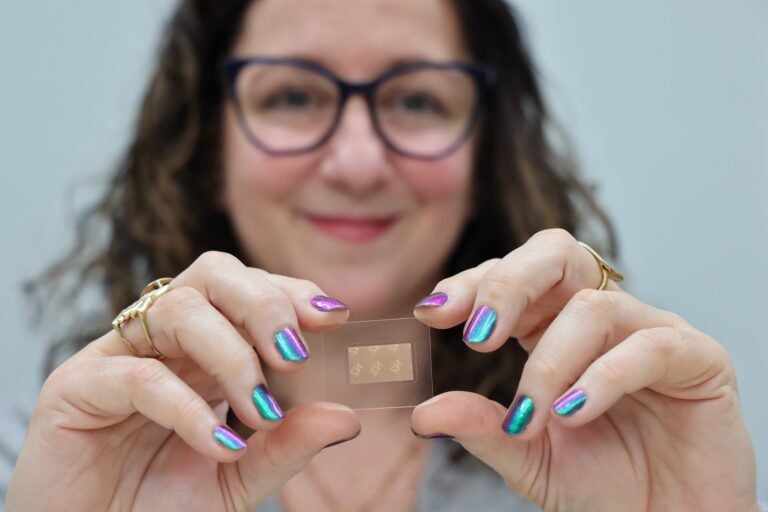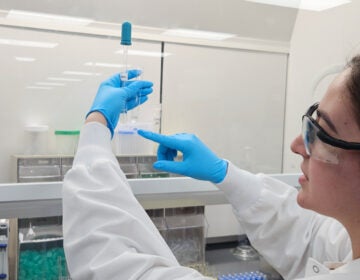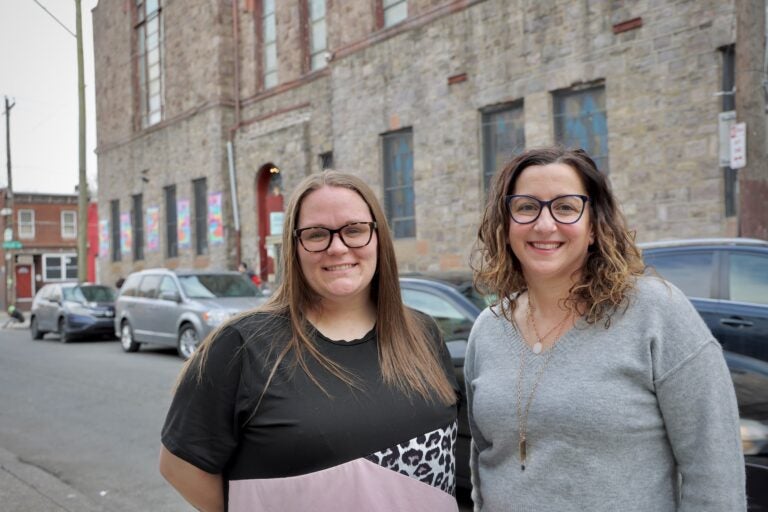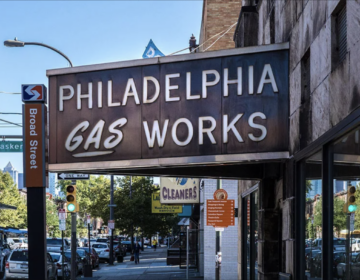Study finds access to lifesaving medication for opioid addiction in Philadelphia remains uneven
A researcher posed as a case manager and called treatment providers across the city to figure out how easy it is to get medication that reduces the risk of fatal overdoses.

Denise Botcheos, behavioral health director at Prevention Point, holds up a Suboxone film, a daily-use medication used to treat opioid dependence. (Emma Lee/WHYY)
From Philly and the Pa. suburbs to South Jersey and Delaware, what would you like WHYY News to cover? Let us know!
Maggie Lowenstein, an addiction medicine specialist, has seen her patients struggling to get access to medications to treat opioid addiction. She’s an internal medicine doctor at Penn Medicine in Philadelphia. And 2021 research confirms her observation — only one in five people who struggled with addiction received medication to treat it, even though these medications have shown to be effective.
So Lowenstein wanted to figure out what it’s like to try to get access to buprenorphine, one of three approved drugs in Philadelphia.
To survey the treatment programs in Philadelphia, a researcher called them, posing as a case manager trying to get a patient into treatment. They asked how long a patient would have to wait for an appointment, whether a patient would be able to get a prescription for buprenorphine and whether the program would require patients to be in counseling to get buprenorphine. They conducted their study from September 2022 to January 2023, and published their findings in a recent journal article.
Overall, they found that despite some advances, access to treatment remains uneven.
They found that programs could offer appointments within a few days. Lowenstein said she was pleasantly surprised by this, as it was an improvement compared to years past. However, only around 42% of the programs said they could offer buprenorphine to a patient immediately, and around 48% could not say whether they require counseling for access to the medication.
“We really shouldn’t be delaying medication starts. This is a lifesaving treatment that cuts the risk of death in half,” Lowenstein said. “And there’s no clear justification for why we wouldn’t do it.”
She added that research shows requiring counseling as a condition for access to treatment does not help, because the medication works with or without counseling. In 2023, the U.S. Department of Health and Human Services said so as well in an open letter to clinicians.
“The mortality of a person who’s had a nonfatal overdose is comparable to … somebody who’s had a heart attack,” Lowenstein said. “The person really needs care as soon as they can get it.”
She said that in her practice, she often sees the consequences of patients who run into hurdles when trying to get medication: “They may be met with very unrealistic expectations … or requirements … that don’t line up with the most up-to-date guidelines that we have. Then their medication is stopped, and they’re right back where they started, which is a really risky situation.”
This happens despite the federal government recently removing hurdles to doctors prescribing medicine to address opioid addiction.
Lowenstein said her most recent findings show that treatment programs still need to be updated to offer services that are in line with the latest evidence.
Unofficially, people who treat patients know which programs work well in Philadelphia, said Nicole O’Donnell, a certified recovery specialist at Penn Medicine’s Center for Addiction Medicine and Policy. She helps get patients into treatment as part of her work with the CareConnect Warmline.
She said that of the thousands of patients she and her colleagues have seen at their program, most of them had already gotten care someplace else, but then their treatment lapsed because they missed an appointment, or were incarcerated, setting them back in their path to recovery.
“We thought it was going to be more focused on new starts into treatment, but it’s really become a safety net for people who have already accessed treatment, and then fall out of treatment for a week or two, and again, are at risk of fatal overdose,” O’Donnell said.
However, there have been more improvements since the time when Lowenstein’s team did their study, said Denise Botcheos, director of behavioral health services at Prevention Point, which helps patients with opioid addiction in Philadelphia. For instance, she said doctors now don’t need to explain the treatments to patients, or convince them to try medications.
“There was a tremendous fear of precipitated withdrawal and extreme sickness, so sometimes it would take days for people to get to the place where they were ready to do it,” she said. “Now, I feel like there’s so much more knowledge out there and people talk to each other.”
Nicole Adams, a case manager at Prevention Point, struggled with opioid addiction herself and used buprenorphine as part of her journey to recovery. She added that there are also more options now, like a long-acting medication that only needs to be injected once a month, rather than taken once a day. For herself, methadone was what finally worked.
“It’s so important that we present patients with many different pathways to recovery, because it’s not just … one size fits all,” Adams said.

Get daily updates from WHYY News!
WHYY is your source for fact-based, in-depth journalism and information. As a nonprofit organization, we rely on financial support from readers like you. Please give today.







